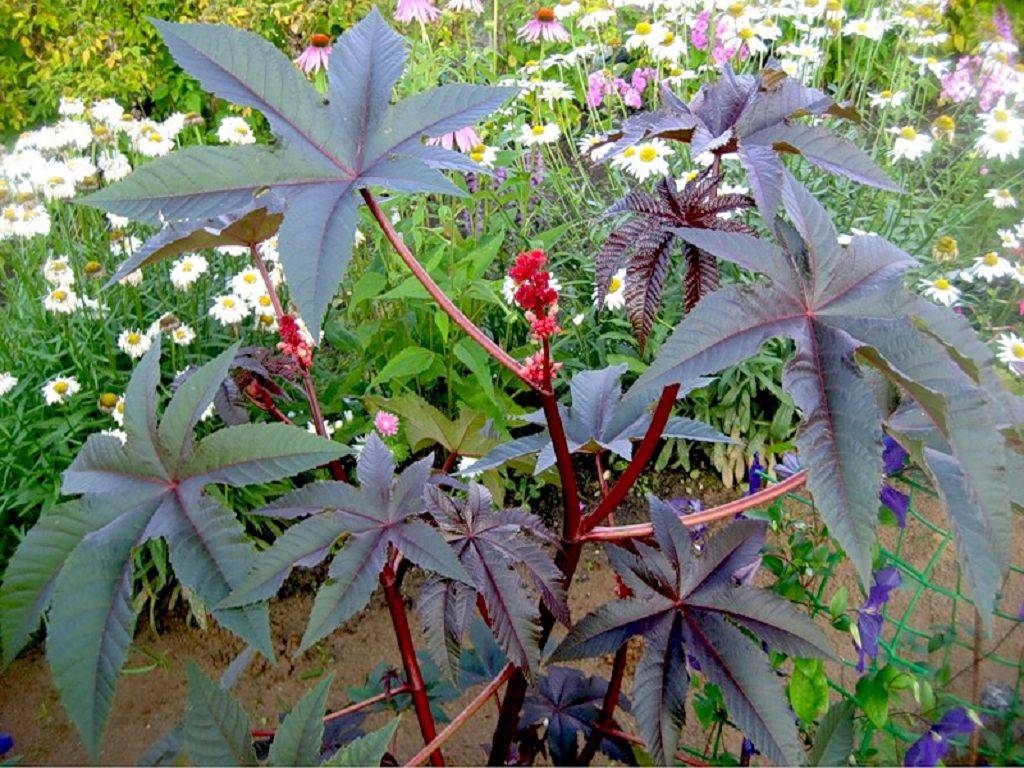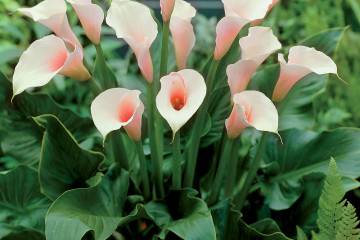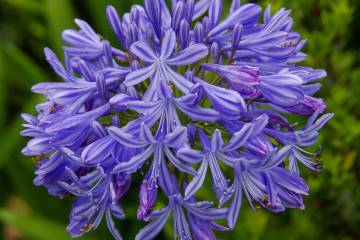Castor oil plant - planting and care in the open field on the site
Content:
Often in the garden you can see powerful bushes with wide patterned foliage. Floriculture beginners mistake the plant for a weed. A perennial called castor oil plant resembles a kind of palm tree. Decorative culture is able to effectively decorate the area near the house. A rather original plant looks amazing when planted along curbs or in the background of a flower garden.
Features of castor bean
The countries of Africa are considered the birthplace of castor oil plants. In a subtropical climate, an ornamental crop can reach a height of more than 9.5 m. The plant is not able to withstand severe winter frosts, therefore, in our country, castor bean is grown as an annual crop.
The bright leaf blades are composed of multiple lobes that resemble maple leaves. The plant creates an amazing atmosphere in the garden. In early July, small stems appear on it. It is on them that flowers that do not differ in bright color begin to bloom.
The castor oil plant is pollinated by the wind, so the flowers do not exude a pronounced fragrance that attracts insects. After the end of the flowering period, balls covered with needles form on the plant. Inside the balls are seeds that can be used for breeding purposes.
Classification of castor bean species
Below you can find the most popular castor bean varieties that can be grown on your site.
Zanzibar castor oil plant
This is a type of fast-growing annual plant, the height of which can exceed 180-195 cm. The racemose inflorescences, in combination with large leaf plates, look quite impressive. The foliage of the Zanzibar variety is colored red and purple.
Castor oil plant (Cambodian)
A kind of decorative culture, the height of which can exceed 100 cm. The stem is painted in black tones. Dark foliage is naturally endowed with large sizes. Floriculture experts recommend planting an Indian variety plant near other castor bean varieties.
Castor oil Gibson
The height of this culture is in the range of 145-150 cm. The leaf plates, painted in a red palette, shine with a metallic shade in bright light.
Borbon castor oil tree
A variety that can grow up to 280-300 cm. The stem of the tall bushes is quite dense. The leaf plates of the variety are painted in green tones. The foliage surface is glossy.
Castor oil plant: growing from seed, when to plant and how to care
When growing an ornamental crop from seed, it is necessary to place the seed pots in well-lit areas. Water seedlings systematically. In order for the plant to be branched and tall, it is necessary to apply top dressing to the soil.
Before sowing seed, you should pickle it with dye and granosan. When selecting seeds for planting, it is better to give preference to a seed on which there are no visible defects.
When to plant castor oil plants depends on the region. But it is best to do this in mid-March, following the step-by-step recommendations of the specialists described below. It is important to properly care for the flower.
Landing order
Castor bean seeds are sown in pre-prepared containers filled with fertile soil with a small amount of peat. The recommended embedment depth is 6.5-7.5 cm.
When planting, it is worth using the dotted sowing method, which allows the seeds to germinate quickly. The container with the landings is taken out into the room, the temperature in which is in the range of 20-22 degrees. The first shoots should be expected on the 5-7th day. The sprouts need systematic watering and sufficient lighting.
Why the castor oil plant grows poorly
When growing seedlings at home, the temperature in the room must not be allowed to rise above 20 degrees. Failure to comply with this rule can cause a slowdown in crop growth and thickening of the stems and leaf plates.
Picking
Planting and caring for castor oil plants is not difficult, so even a beginner in the field of floriculture can cope with the cultivation of an ornamental culture. When growing seedlings of a fast-growing plant, it is necessary to correctly perform a pick. The event is held during the period when the air temperature does not drop below 12 degrees at night.
The seedlings are not removed from the container, and their root system is not cleared of the soil layer. When diving, it is recommended to transfer the plant along with the soil from the pots directly into the recesses dug in the flower bed. Compliance with this recommendation will allow you to achieve quick survival of castor bean in the open field. The plant must be watered regularly and abundantly. As a rule, the soil is moistened every other day.
Castor oil plant: planting and care in the open field
One of the most interesting questions for those who want to decorate their site with this culture: how to plant castor oil plant from seeds immediately to a permanent place. Castor bean seeds are planted in open ground in the 20th of May, when the threat of night frosts has passed.
The grower must find a permanent place for the culture, which will avoid transplants, which can negatively affect the appearance of the bushes. When choosing a place for planting seeds, it is worth giving preference to areas that are well lit by the sun's rays and protected from gusts of wind.
The seeds are sown in holes located at a distance of 100 cm from each other. 2-3 seeds are poured into each groove. The recommended hole depth is 5.5-7.5 cm. The planting site is moistened.
Growing from castor bean seeds is a fairly simple and fun process. The most important thing is to follow the recommendations of specialists regarding the care of seedlings. It is also worth thinking about how to feed the castor oil plant. This will make it possible to grow tall bushes, which will become a real decoration of the garden plot.
Features of castor oil care
An unpretentious decorative culture does not need complex care. The most important thing is to ensure the flower is properly watered.
In just 4 weeks, the seedlings planted in open ground will reach a height of 100-120 cm, depending on the castor bean variety.The plant develops very quickly, so it is necessary to systematically moisten the soil.
Basic recommendations for the care of a poisonous plant.
Watering
It is necessary to systematically moisten the soil (every day or every other day, depending on weather conditions). It is recommended to pour 8-12 liters of water under adult bushes. During the flowering period, the amount of water that pours out under the bush increases to 15 liters.
Weeding
This operation should be performed every week. Weed grass drowns out the growth of castor oil plants, so it is necessary to get rid of it.
Loosening
You need to loosen the soil constantly, a couple of hours after each watering. This will make it possible to saturate the earth with oxygen and prevent the formation of a crust on the soil.
Installation of supports
Driving pegs around mature bushes and pulling on dense threads makes it possible to create support for the crop and keep the plant upright.
Top dressing
How to feed castor oil plant for rapid growth is not an easy question. In order for the bushes to be tall and the shoots to develop quickly, it is necessary to apply a fertilizer containing nitrogen to the soil. Poultry manure is an excellent source of nitrogen.
Organic fertilizing is applied to the soil in small quantities. High levels of uric acid can damage the root system of the plant, so do not use fresh droppings.
It is best to stir a small amount of droppings in a bucket filled with rainwater and let sit for a couple of weeks. During this period, the litter will have time to ferment. 500 ml of top dressing is applied under each castor bean bush. After the cysts of flowers are formed, it is necessary to apply phosphorus-potassium fertilizer to the soil.
Bloom
In the middle of summer, the castor oil plant releases arrows, which will subsequently turn into inflorescences of a bright shade. In some cases, the culture may cease to please with flowering. To rectify the situation, it will be necessary to systematically introduce nitrogenous fertilizing and water abundantly unusual exotic flowers.
Preparing for winter
In the climatic conditions of our country, an exotic plant is grown as an annual. Culture cannot survive severe winter frosts.
Post-flowering care
After the flowering of the plant, balls with needles are formed on the bushes. It is in them that seeds are formed, which contain poison.
To collect seeds, you will need to cut the boxes at the end of September, dry them for a couple of weeks in the open air. After that, you can remove the grains of the spotted color. To store seeds, you need to find a safe place that children and animals cannot get to, because just a few seeds can cause death.
Possible growing problems
The castor oil plant is not susceptible to disease and belongs to the category of hardy plants. With an incorrectly selected irrigation regime, the leaf plates of the crop may turn yellow. In this case, it is necessary to water the castor oil plant more often and systematically loosen the soil.
In some cases, bushes can suffer from black rot and powdery mildew. It is important to remove the affected shoots as soon as possible, and treat the bush with Bordeaux liquid.
Also castor oil plant can suffer from the invasion:
- wireworm;
- sandy linger;
- caterpillars of meadow moths;
- meadow bugs.
To cope with the wireworm, it is enough to water the soil abundantly with a weak solution of manganese. In case of an invasion of caterpillars, it is necessary to collect the latter and process the plants with a solution of wormwood. To do this, you need to collect the grass (half a bucket). Chopped greens are poured into a bucket of water and infused for several days. After straining, it is necessary to spray the shoots, soil and leaf plates of the bushes.
Benefit and harm
Castor bean seeds contain a high percentage of fatty oil, which is why they are used by pharmacists in the process of making castor oil. Also, the plant is used for the preparation of cosmetic products.
At the same time, do not forget how dangerous the decorative culture is for both animals and people. The flowers and seeds of castor bean contain the most dangerous poisonous substance - ricin. Only 6.5-7 g of consumed semen will become a deadly poison for an adult, and 2-3 g will lead to death of children and animals.
In no case should any part of the plant be used in the cooking process. In case of accidental consumption of seeds or flowers of an exotic plant, it is recommended to rinse the stomach as soon as possible and call an ambulance.
Castor oil plant is an amazing and very dangerous plant. With proper care, the bushes will delight you with beautiful flowering and become a real decoration of the garden area. If you wish, you can collect flower seeds and propagate an exotic culture on your own.





















